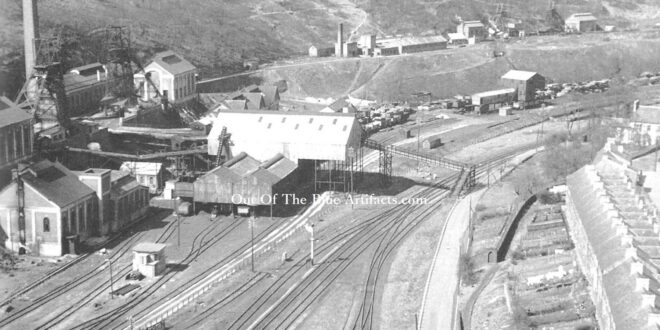Aberbeeg Colliery (South)
There isn’t a great deal of information or many photographs of the Aberbeeg (South) Colliery (as seen in the image upper right. The colliery on the left was the Crumlin Navigation Colliery). It was late in the sinking operations and seems to be a forgotten pit.
The Aberbeeg Collieries Ltd.
In January 1924 it was announced in the local papers that a new colliery company had been set up called the Aberbeeg Collieries Ltd and had been registered as a private company on January 1st, 1924.
The object of the company was –
1/ To acquire the leasehold mines land and premises at Aberbeeg Monmouthshire known as Aberbeeg Colliery and certain plant machinery the appliances connected therewith.
2/ The under-leases of Messrs Partridge, Jones and John Paton & Co of the Tillery red ash seam of coal and the fire clay associated therewith under lands in surface rights of which the said colliery and company are lessees to adopt an agreement with Budd & Co, Newport and to carry on the business as colliery proprietors, miners, quarrymen, patent part manufacturers, carriers, shippers, wharfingers and haulage contractors etc.
The Directors of the Company.
The first directors of the new company were – Mr John Paton, Waun Wern, Pontypool; Mr F. S. Budd, 98 Dock Street, Newport (Colliery Proprietor); Mr F. A. Smith, Ty Bryn Abersychan (Company Director); Mr W. R. Jones, Snatchwood Park, Pontypool (Company Director); Mr C. M. Budd, The Grange, Abergavenny (Colliery Proprietor); Messrs J. Paton, F. A. Smith and W. R Jones are nominees of Partridge, Jones and John Paton Ltd. and F. S. Budd, C. M. Budd and C. F. N. Budd are nominees of Budd & Co. The qualification was £1,000. Re-numeration £300 per annum divided between them, The secretary Mr J. A. Chapman and the registered office – Newport Monmouthshire.
The Naming of the Colliery.
During the founding and sinking of the colliery it was decided to name it the Aberbeeg Colliery, this name clashed with the established colliery at Aberbeeg so it was decided to name the new colliery Aberbeeg (South) Colliery as of its location. The old Aberbeeg Colliery at Aberbeeg was named the Aberbeeg (North) Colliery.
In August 1924 it was announced that new sinking operations were expected to commence on the western side of the River Ebbw between the Royal Oak and Crumlin. The Aberbeeg Company had been in negotiations with the landowners to work coal under Pentwyn, Pantglas, Kendon and other estates. It was also reported that the company were unsure if there were to be one or two shafts sunk, in the event that one shaft was sunk the company would make arrangements that the new colliery “Aberbeeg House Coal Colliery” would be a downcast shaft and another existing colliery in the close vicinity would provide the up-cast ventilation.
The Official Opening of the Aberbeeg (South) Colliery.
There was no evident official opening of the colliery, it seemed to have been a gradual opening in conjunction with the closure of the Aberbeeg (North) Colliery.
In November 1924 a new coal seam was struck, the news was announced by the Aberbeeg Collieries Company Limited. The seam was the household coal seam and that the sinking operations had been on-going for over a 12 month. The whole of the work had been carried out under the supervision of Mr Vivian Phillips M.E., Manager. (According to this report it seems that the initial date of sinking was set back?)
On Friday 30th of October 1925, the colliers at the Aberbeeg (North) Colliery had their notices issued, though suddenly withdrawn, but were then on a day-to-day contract owing to the uncertainty of the underground conditions following the recent flooding and faults on the coal seam. The report went on to state that the new enterprise at the new pit “Aberbeeg South” was opening out rapidly and was hoped to be open before the end of the year.
Aberbeeg North Colliery.
A report from Saturday 17th of April 1926, the Aberbeeg (North) Colliery at Aberbeeg, owned by Messrs Budd & Co, Newport, had finally closed it had been recently carried on at a great expense but owing to the water problems and the fault they had no option but to close it down. It was understood that the men – 150 of them would be transferred to the “new colliery” which is still opening out.
The same report noted that “Aberbeeg (North) Colliery would not be dismantled as yet as the pumps-men would still continue to work, for the old workings were extended towards the new pit in Crumlin and if the water were to be allowed to accumulate there would be an adverse effect at the Crumlin end – When the new pit is in production all the coal that the North Colliery leaves behind will be mined and brought to the surface at the South Colliery”.
The Later Years.
In 1947 the Aberbeeg (South) Colliery was taken over by the National Coal Board.
In January 1956 the Aberbeeg Collieries Company Limited was officially liquidated.
The Closure of the Colliery.
I am unsure as to the actual date the colliery closed although its closure was mentioned in the South Wales Gazette in November 1965.
 Out Of The Blue Artifacts A Library of a lifetime of collecting
Out Of The Blue Artifacts A Library of a lifetime of collecting
